Michael Gallagher's Blog, page 3
August 1, 2018
August 2018: Build yourself a brand, part two
 Spamming reviewers, book bloggers, and reading groups with offers of free copies of your book in exchange for an honest review wastes both their time and yours, and can seriously damage your reputation. So how, as a newly published author, might you better employ your time?
Spamming reviewers, book bloggers, and reading groups with offers of free copies of your book in exchange for an honest review wastes both their time and yours, and can seriously damage your reputation. So how, as a newly published author, might you better employ your time?Offer free copies of your book on your website
Offer free or heavily discounted copies of your book with no strings attached (though be aware that a free offer is much more likely to be taken up). By now you should have plenty of sites on which to do this. Try to ensure that the text of your offer makes the genre and style of your book perfectly clear; you’ll have much happier readers if you do. Consider the text of the giveaway at the bottom of this post for example. What can you glean from it? It’s for a well-researched cozy mystery set in Victorian times (so not exactly steampunk), it’s slightly comic, and the detective is a bit of an underdog. Possibly not one for lovers of the police procedural, then.
Review books in your own genre
Read regularly within your genre to see how other writers tackle the same material that you do. Use Goodreads and LibraryThing to publish your reviews; they make you more discoverable as a person. Never be disparaging about a fellow author’s work; if you don’t like a book, don’t review it. Your readers would much rather see the books you actually enjoyed.
Start a special interest blog
Find a topic that relates to your book and dedicate a blog to it; it’s free at Blogger.com. Put in links (especially in the sidebar) to make yourself more discoverable, but first and foremost design your blog to be useful to people who might visit the site. Take a look at Murder Most Cozy to see what I mean: the search box on the right, the clickable list of authors below it (made by using tags on posts—what Blogger calls “labels”). Even blogs you discontinued writing long ago can bring in new hits if they’re interesting enough. The Victorians Unveiled, for example, still brings me about a thousand views per year. Hardly trending, I know, but still none too shoddy for what is essentially a dead blog!—and each of those views holds the potential for somebody new to discover me.
Invest in paid advertising
You might do worse than invest in some paid advertising, for example on Facebook, Amazon, or Google. Goodreads also offers ads and here you have access to a vast community of readers. You can target your book at a specific audience, and it’s great value for money.
Keep things fresh
Keep your author photo and bio, your author pages, links, and any other online publicity material fresh and up to date. Regularly update your book to reflect these changes. Most importantly: write your next book, then your next, then another—as counter-intuitive as this may sound. At a time when the market is drowning, brands stand out.
 This month’s special offer is for Octopus: Octavius Guy & The Case of the Throttled Tragedienne (#2). When the leading actress dies in mysterious circumstances during a performance of The Duchess of Malfi, Gooseberry feels duty-bound to investigate. It is, after all, a great deal more exciting than the last case he was assigned to: the tracking down of a rich old lady’s errant cat! Offer ends on August 31st 2018, and no, there are no strings attached and no review is required. Phew! You’ll find links and details on my website.
This month’s special offer is for Octopus: Octavius Guy & The Case of the Throttled Tragedienne (#2). When the leading actress dies in mysterious circumstances during a performance of The Duchess of Malfi, Gooseberry feels duty-bound to investigate. It is, after all, a great deal more exciting than the last case he was assigned to: the tracking down of a rich old lady’s errant cat! Offer ends on August 31st 2018, and no, there are no strings attached and no review is required. Phew! You’ll find links and details on my website.“Historical fact is deftly combined with fiction that makes Octavius’s world a new form of old London that I am eager to visit again. Pour some tea or a wee dram, put your feet up, and enjoy cover to cover.”—Gladread LibraryThing Early Reviewer (5 stars)
Happy reading!
Michael
Find me on my website Michael Gallagher Writes
on Facebook
follow me on Twitter @seventh7rainbow
and visit Murder Most Cozy for a round up of the coziest Crimes & Thrillers reviews
Published on August 01, 2018 01:33
•
Tags:
advice-for-authors, building-a-brand
July 1, 2018
July 2018: Build yourself a brand, part one
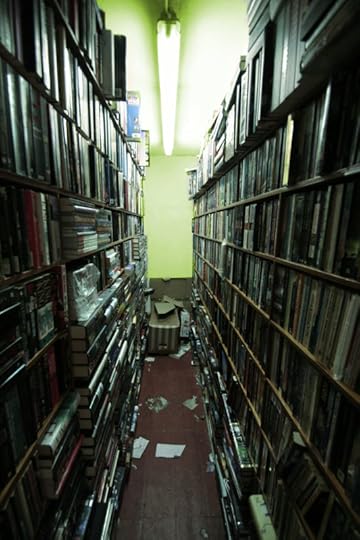 Unless you want to see your title relegated to the virtual, dusty stacks of some forgotten neural-net byway, you need to devise ways of keeping interest in it and in you alive. Your goal now is to become more discoverable. Some of the things I suggest here you will already have done; others may seem like household chores, but they serve a purpose. They build your brand.
Unless you want to see your title relegated to the virtual, dusty stacks of some forgotten neural-net byway, you need to devise ways of keeping interest in it and in you alive. Your goal now is to become more discoverable. Some of the things I suggest here you will already have done; others may seem like household chores, but they serve a purpose. They build your brand.Use social media
A blog or a website is a good start, and there are many options available—including setting up your own (paid), or at Blogger (free), or with Wordpress (free or paid). Just be sure to post regularly. It shows readers that you’re serious. Even 200 words a month, every month, is far better than a sporadic post or two, the last of which was made some six months ago or more. Set up author pages/accounts on social media, Facebook and Twitter being obvious choices (but there are others), preferably to engage people (rather than to flood their feeds with adverts for your book). Learn how to write links for your sites (such as the ones you can click on here) and include them wherever appropriate, especially in sign-offs (see the bottom of this post) and, more to the point, in your book itself.
Set up author pages
If you meet certain criteria, you may be entitled to set up author pages at Amazon Author Central, Smashwords, Goodreads, and LibraryThing. You may also wish to consider Authors Den, a free or paid service targeted at aspiring authors (as opposed to readers)—though you do get to list your books with links to where they can be purchased. Create a short, snappy bio and find the best photo of yourself that’s available. Goodreads allows their authors to have a blog page (which you can rss-feed to your Author Central page by clicking on the rss icon on your blog, copying the URL, and pasting it into your Amazon page template, where it will update automatically every time you post), so make use of it. Read Goodreads’ guidelines for authors and abide by them always. They are indispensable.
Make the most of reviews you’ve commissioned
If you gave away your book at LibraryThing in exchange for an honest review, monitor these as they come in and contact reviewers by email to thank them and to politely ask if you may use what they’ve written for future publicity. At the same time, inquire if they would be willing to post their reviews wherever they feel comfortable. Provide links to the relevant book pages (e.g. at Smashwords, Amazon, Goodreads) to make this easy for them. Update your book to include snippets of the best reviews in the front matter (and on the back cover for print-on-demand)—and, of course, put them on your website. Reviews that arrive late are a godsend; they indicate to anyone perusing them that interest in your book is still alive.
Do not spam!
Don’t waste your time or anyone else’s on spamming reviewers, book bloggers, reading groups—and yes—even fellow authors with offers of free copies, especially in exchange for reviews. That ship has long since sailed. At best you’ll be ignored; at worst you will create a bad impression of yourself (and of the book you are trying to publicize). Instead why not consider employing your time on some of the strategies I’ll be suggesting next month. Join me then.
 This month’s special offer is for Gooseberry: Octavius Guy & The Case of the Thieving Maharajah (#1). Join Gooseberry, the fourteen-year-old Victorian boy detective, as he and his ragtag bunch of friends descend into London’s Victorian demi-monde and underworld to ferret out the truth, while spending as much of his employer’s money as they can along the way! Based on characters from Wilkie Collins’s The Moonstone, and first published as a weekly serial right here on Goodreads. Offer ends on July 31st 2018. You’ll find links and details on my website.
This month’s special offer is for Gooseberry: Octavius Guy & The Case of the Thieving Maharajah (#1). Join Gooseberry, the fourteen-year-old Victorian boy detective, as he and his ragtag bunch of friends descend into London’s Victorian demi-monde and underworld to ferret out the truth, while spending as much of his employer’s money as they can along the way! Based on characters from Wilkie Collins’s The Moonstone, and first published as a weekly serial right here on Goodreads. Offer ends on July 31st 2018. You’ll find links and details on my website.“When you read a book by Michael Gallagher be prepared for a total immersion—every bit of scene setting, speech, character and historical detail is perfect. I highly recommend this book for fans of The Moonstone who wonder what happened next.”—Chris Keen LibraryThing Early Reviewer (5 stars)
Happy reading!
Michael
Find me on my website Michael Gallagher Writes
on Facebook
follow me on Twitter @seventh7rainbow
and visit Murder Most Cozy for a round up of the coziest Crimes & Thrillers reviews
Published on July 01, 2018 01:16
•
Tags:
advice-for-authors, building-a-brand
May 31, 2018
June 2018: Are authors getting pushier?
 So who was the other guest at the wedding, the one who works in publishing? Martin, a charming man who runs a small-to-medium company, with whom I had an unexpectedly pleasant chat. “Time was,” he said, “when reading groups would beg authors to come and talk about their latest books. Now authors go round begging the groups!”
So who was the other guest at the wedding, the one who works in publishing? Martin, a charming man who runs a small-to-medium company, with whom I had an unexpectedly pleasant chat. “Time was,” he said, “when reading groups would beg authors to come and talk about their latest books. Now authors go round begging the groups!”He was responding to what I’d told him about a reading group I attend, a small, in-the-flesh Crimes & Thrillers group that I’d recently set up a Facebook page for, where people round the world can see and comment on what we’ve been reading. My fellow members and I soon realized that most of the people asking to join were authors who had no interest in what we were reading. They simply wanted to promote their own books. Some were pushy; some were patronizing, suggesting ever so subtly how they were doing us a great favour. The best of those who joined (whose posts I hated removing) were polite. I quickly amended our mission statement. Now no one—me included—is allowed to to publicize their own books. When even that didn’t work, I made it a pre-condition of joining.
For indie authors (and now for traditionally-published authors, who are increasingly obliged to do their own marketing), finding ways to publicize their book outside their own social network can be a nightmare. With anything between two and four million new titles published each year, how are they to get their book read and reviewed without resorting to spamming?
One cheap and cheerful way to generate reviews is to offer free copies on LibraryThing. Write a blurb to attract your target audience. For instance, if it’s a cozy mystery, fans of the police procedural may think that it’s pants. On average, approximately only 30 percent of those who “win” your book will end up reviewing it, and you can wait months if not years for those reviews to roll in—which is actually no bad thing, as I’ll be discussing next month.
For the first time ever, Goodreads now offers a giveaway service for ebooks. You can give away up to 100 copies of your novel for a set fee of either US$119 for their standard or US$599 for their premium option. Be aware that winners are not contractually obliged to review your book, though you can encourage them to share their thoughts/favourite passages on Goodreads using the new Kindle Notes & Highlights. It’s early days, though I would expect to see roughly the same percentage of reviewers as with the LibraryThing giveaway.
NetGalley offers a similar service, with rates ranging from US$199 to $699, though in this case their membership is tailored to people with connections to the book trade: publishers, reviewers, and book bloggers. This service works best before the general release of your book, generating buzz for you, as people like to call it.
Another rather high-end option is to purchase a single review, possibly from a blogger with a large following (though I suggest you only consider this if you happen to follow the blogger in question yourself). Instead go for a reputable and highly respected organization with an indie arm, such as Kirkus. Their services start at a cool US$425, which, given that someone has to read your book and write about it in quite a short time-frame, hardly seems unreasonable. If the review is favourable, you can cherry pick a quote for your front matter, your cover, or both. If it’s not, you can ignore it and ask them to remove it from their website. It’s still quite a lot of money, though, for no guaranteed return.
 This month’s special offer is for The Scarab Heart. This time our reluctant medium is off to the Valley of the Kings, where she finds herself embroiled in an ancient family feud, and gets caught up in antiquities theft and murder. Offer ends on June 30th 2018, and, no, there’s absolutely no review required! You’ll find links and details on my website.
This month’s special offer is for The Scarab Heart. This time our reluctant medium is off to the Valley of the Kings, where she finds herself embroiled in an ancient family feud, and gets caught up in antiquities theft and murder. Offer ends on June 30th 2018, and, no, there’s absolutely no review required! You’ll find links and details on my website.“I have got to say, these books are unlike any other I have read…almost impossible to put down.”—Helene Gårdsvold Amazon.com Reviewer (5 stars)
Happy reading!
Michael
Find me on my website Michael Gallagher Writes
on Facebook
follow me on Twitter @seventh7rainbow
and visit Murder Most Cozy for a round up of the coziest Crimes & Thrillers reviews
Published on May 31, 2018 23:31
•
Tags:
advice-for-authors, generating-reviews, spamming
May 1, 2018
May 2018: Legacy publishing houses, purveyors of quality?
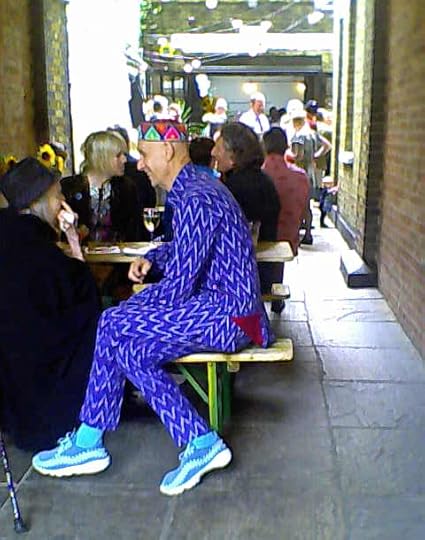 Last August I attended a wedding where, for the first time, I met two people who are or were involved in the world of traditional publishing. One was Fiona, a former manager at a large prestigious publishing house, who, it turned out, commissioned a report fourteen years ago on an early draft of my first novel, The Bridge of Dead Things.
Last August I attended a wedding where, for the first time, I met two people who are or were involved in the world of traditional publishing. One was Fiona, a former manager at a large prestigious publishing house, who, it turned out, commissioned a report fourteen years ago on an early draft of my first novel, The Bridge of Dead Things.It “quickly establishes itself as a remarkably assured, well-written, funny and complex Victorian Gothic,” the report read. “It is at the very least extremely good, and quite possibly exceptional…but it’s definitely not a HarperCollins children’s book. More Wilkie Collins than The Diamond of Drury Lane, in other words.”
Prescient, no? I’d never thought of it as a children’s book, but as rejection letters go, they don’t get much better than that! It went on to recommend I find myself a literary agent, which I did, though it took a further four years. I mention all this to establish my credentials. Although I may now be an indie author, at one time or other I have had my feet in both camps. It used to be that the reading public could rely on the good reputation of legacy publishing houses. They would be spared the spelling errors and ragged grammar that supposedly typify an indie author’s work. But is that really still the case?
Hands up those of you who have come across multiple typos and poorly-spaced text (where five words are strung out across a line like a few bits of pegged-out washing) in any of the traditionally-published hard-copy books you’ve read lately? Ah. All of you then. In one I recently came across, a sentence petered out halfway through. Cut off in its prime. In another—or possibly the same one—one character started speaking before miraculously transforming himself into another (the one who should have been speaking all along). The arts of typesetting and proofreading aren’t dead; they’re just no longer guaranteed.
And it’s not as if traditional publishers seem especially au fait with the genres we read. One claimed that their author was famed for his “comic book series”. Presumably they meant “graphic novel series”, and not some unintentional put-down. And I’m not sure any of them knows what a “cozy mystery” is (but we know, don’t we, readers?).
Nor is their disservice limited to readers. Authors get it too. A three-book deal with a big, fat advance? If your first title fails to make back that advance, the remainder accrues to the second title, and then the third. Royalties used to be based on the selling price of your book. Where books were discounted, this led to proportionately lower receipts. Children’s author Nicola Davies (@nicolakidsbooks) sold over 13,000 copies of one of her titles and received just £800. That’s about 16 pence per copy. But more and more, royalties are being based on the publisher’s net receipts—not on the book’s retail price—after all of their costs are deducted. And I’m sure this will have a knock-on effect for the 25-40% of your royalties that go to your agent. They won’t be much pleased. My biggest bugbear at the moment, however, is to do with publishers’ territorial rights, and the short-sighted, parochial unwillingness for their counterparts in other countries to take on a title if they don’t think their readers will accept the colloquialisms it contains. Case in point: Charlotte MacLeod. She’s virtually unknown here in the UK. And that truly is a crime!
While it’s true that, at a time when the market is flooded, brands stand out, as readers and authors we cling to this cheery notion very much in the sense of “between a rock and a hard place”.
 This month’s special offer is for The Bridge of Dead Things. A working-class Victorian girl discovers she has a unique if unwanted power and is soon drawn into a world of seances, ghost grabbers…and murderers. Definitely not a HarperCollins children’s book! Offer ends on May 31st 2018. You’ll find links and details on my website.
This month’s special offer is for The Bridge of Dead Things. A working-class Victorian girl discovers she has a unique if unwanted power and is soon drawn into a world of seances, ghost grabbers…and murderers. Definitely not a HarperCollins children’s book! Offer ends on May 31st 2018. You’ll find links and details on my website.“I absolutely loved it! I don’t give out 5 stars very often, but I did for this book! Mysteries abound and Gallagher does an amazing job creating an atmosphere of rising fear and creepiness…I hope that there are many more additions to the Lizzie Blaylock series because I now consider myself a firm fan!”—Suzy Schettler LibraryThing Early Reviewer (5 stars)
Happy reading!
Michael
Find me on my website Michael Gallagher Writes
on Facebook
follow me on Twitter @seventh7rainbow
and visit Murder Most Cozy for a round up of the coziest Crimes & Thrillers reviews
Published on May 01, 2018 06:13
•
Tags:
current-state-of-publishing
April 1, 2018
April 2018: The current state of publishing
 I’m back! Or perhaps I should say: my back! It’s still giving me problems, sitting for any length of time to write being just one of them. But I couldn’t ignore this post for it marks my website’s fifth birthday. Yes! Now we are five! My enforced inactivity has given me plenty of time to read however (and I have read some particularly good thrillers of late and discovered some truly wonderful authors). It also gave me time to think about the current state of publishing. It’s never been easier to publish your novel yourself and see your own words in print. Nor harder to find anyone who is prepared to read it, let alone shell out good money for the privilege. Why? Over the next few months I’ll be reflecting on this and other matters to do with publishing in an extended series of posts.
I’m back! Or perhaps I should say: my back! It’s still giving me problems, sitting for any length of time to write being just one of them. But I couldn’t ignore this post for it marks my website’s fifth birthday. Yes! Now we are five! My enforced inactivity has given me plenty of time to read however (and I have read some particularly good thrillers of late and discovered some truly wonderful authors). It also gave me time to think about the current state of publishing. It’s never been easier to publish your novel yourself and see your own words in print. Nor harder to find anyone who is prepared to read it, let alone shell out good money for the privilege. Why? Over the next few months I’ll be reflecting on this and other matters to do with publishing in an extended series of posts.When Amazon launched its digital publishing arm, Kindle Direct Publishing, a little over a decade ago—followed swiftly by its indie-friendly competitor Smashwords—it signalled the start of a publishing gold rush. A shaky start, admittedly. In the first seven months Smashwords had published a meagre 140 titles. But within four and a half years E. L. James’s self-published Fifty Shades of Grey became the first ebook to sell one million copies on Amazon. Suddenly anyone who could put finger to keyboard imagined they might do the same!
But now it’s six years on and we’re no longer at the start, but mired somewhere in the middle—with the market not just flooded but drowning. Up-to-date figures are hard to come by, but a reasonable estimate is that approximately 2 to 2.5 million new titles (both traditional and self-published) are released worldwide each year. New titles! Each year! The majority hail from China (440,000 in 2013, or approximately one-fifth of all new releases) and presumably appeal to a market specifically limited by language—but even so! It’s a frightening prospect, but with self-publishing and distribution made so easy these days there may now be as many authors as there are regular readers (or, rather worryingly, even more authors than there are regular readers!).
With these odds, how is the reading public to judge the worth of any given title? How can they know that someone’s lovingly-crafted title even exists? It used to be they could rely on the good reputation of the legacy publishers. So-and-so published it, so it must be good…or at least of a certain quality. Join me next time to judge whether that is still the case.
 This month’s special offer is for Big Bona Ogles, Boy!: Octavius Guy & The Case of the Mendacious Medium (#3). There’s a new woman in town, recently arrived from Boston, who claims to be able to contact the dead. Need it be said that our Victorian boy detective remains unconvinced? Offer ends on April 30th 2018 and, no, there are no strings attached. Why shell out good money if you don’t have to? You’ll find links and details on my website.
This month’s special offer is for Big Bona Ogles, Boy!: Octavius Guy & The Case of the Mendacious Medium (#3). There’s a new woman in town, recently arrived from Boston, who claims to be able to contact the dead. Need it be said that our Victorian boy detective remains unconvinced? Offer ends on April 30th 2018 and, no, there are no strings attached. Why shell out good money if you don’t have to? You’ll find links and details on my website.“My favorite Victorian boy investigator sets off to solve a new mystery…Words cannot describe just how much I enjoy Octavius.”—Bethany Swafford (The Quiet Reader) Goodreads Reviewer (5 stars)
Happy reading!
Michael
Find me on my website Michael Gallagher Writes
on Facebook
follow me on Twitter @seventh7rainbow
and visit Murder Most Cozy for a round up of the coziest Crimes & Thrillers reviews
Published on April 01, 2018 05:43
•
Tags:
current-state-of-publishing
March 1, 2018
March 2018
 Winter is here, and I’m not just talking about Game of Thrones Season 7, which I got to watch for the very first time just last week—their best writing yet! My back continues to heal apace but, again, no new post I’m afraid. This month’s special offer is for Octopus: Octavius Guy & The Case of the Throttled Tragedienne (#2). This time the fourteen-year-old Victorian boy detective is off to enjoy an evening at the theatre…with unexpected and truly tragic results. Offer ends on March 31st 2018.
Winter is here, and I’m not just talking about Game of Thrones Season 7, which I got to watch for the very first time just last week—their best writing yet! My back continues to heal apace but, again, no new post I’m afraid. This month’s special offer is for Octopus: Octavius Guy & The Case of the Throttled Tragedienne (#2). This time the fourteen-year-old Victorian boy detective is off to enjoy an evening at the theatre…with unexpected and truly tragic results. Offer ends on March 31st 2018.“Here is a sensational historical fiction who-dunnit that gives nothing away until the very end. To me, it reads like an old time radio show. It leaves you breathless.”—Connie A, LibraryThing Early Reviewers (5 stars)
Happy reading!
Michael
Find me on my website Michael Gallagher Writes
on Facebook
follow me on Twitter @seventh7rainbow
and visit Murder Most Cozy for a round up of the coziest Crimes & Thrillers reviews

Published on March 01, 2018 06:57
February 1, 2018
February 2018
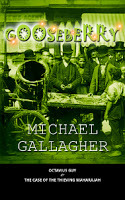 Hi! No new post this month because I hurt my back before Christmas and it’s going to take a little while for it to heal. By way of recompense let me offer you a free download of the first book in the series, Gooseberry: Octavius Guy & The Case of the Thieving Maharajah. You’ll find the links you need on my Facebook page. A perfect antidote for those winter blues (or something to soak up on the beach in the height of summer, depending on your hemisphere)!
Hi! No new post this month because I hurt my back before Christmas and it’s going to take a little while for it to heal. By way of recompense let me offer you a free download of the first book in the series, Gooseberry: Octavius Guy & The Case of the Thieving Maharajah. You’ll find the links you need on my Facebook page. A perfect antidote for those winter blues (or something to soak up on the beach in the height of summer, depending on your hemisphere)!Happy reading!
Michael
Find me on my website, where you’ll discover regular special offers on all of my novels
on Facebook
and follow me @seventh7rainbow
January 1, 2018
January 2018: Resolutions
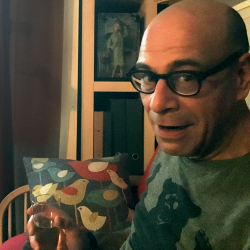 Happy New Year, dear friend, dear reader, or simply dear curious person who happened to stumble upon this page! First let’s get what I pray is the last of my print-on-demand mistakes out of the way, so we can move on to the New Year’s resolution that terrifies me. The mistake? It was the pricing. When I priced them to make approximately US$0.30c each on Amazon.com, it turned out that I still earned not a penny at every other Amazon site in the world. I have redressed this situation by pricing them all (bar the slightly cheaper Gooseberry) at US$9.99—UK£7.50—which brings in a royalty of around 40 pence from each. I hated having to do it, but I try to console myself that they still come in at under ten dollars (just), and are roughly in line with UK paperback prices for comparable books.
Happy New Year, dear friend, dear reader, or simply dear curious person who happened to stumble upon this page! First let’s get what I pray is the last of my print-on-demand mistakes out of the way, so we can move on to the New Year’s resolution that terrifies me. The mistake? It was the pricing. When I priced them to make approximately US$0.30c each on Amazon.com, it turned out that I still earned not a penny at every other Amazon site in the world. I have redressed this situation by pricing them all (bar the slightly cheaper Gooseberry) at US$9.99—UK£7.50—which brings in a royalty of around 40 pence from each. I hated having to do it, but I try to console myself that they still come in at under ten dollars (just), and are roughly in line with UK paperback prices for comparable books.But what is the New Year’s resolution that terrifies me, you ask? I’ve decided it’s high time that I got to grips with Twitter. I get Facebook. I really do. I took to it like a fish to water. I have my private page for my friends. I have my public pages for readers. I even set up a group page for my Crimes & Thrillers reading group. And I know exactly when and what to post on each. Twitter, however? Hmmm. Not so much.
Maybe it’s because I don’t have a smart phone, or even a half-decent camera built into the ancient mobile that I do have. Taking two blurry, unflattering photos is enough to drain its battery. So where Twitter is concerned, I don’t have a hope in hell’s chance of posting visuals-on-the-go to document my scintillating—or not so scintillating—life, which is a massive disadvantage in this very visual medium. Then there’s the fact that I don’t have an internet connection at home. To post just one of those tiny messages means taking a trip to my local library. As wonderful as that may be (and, no, I’m not being sarcastic, I LOVE my local library), it is hardly conducive to spontaneous outpourings of a fevered brain, you have to admit.
Then there’s the medium itself. The one campaign I took an active part in (a week-long celebration of mystery books set up by Goodreads) was a bit of an eye-opener for me. When I looked at the tweets that went up using their hash tag, they read like they were from a bunch of people shouting pointlessly into the Ether. No one seemed to be speaking to each other; indeed, nobody seemed to be listening to each other, or even listening at all. The saddest tweet I found (I’m guessing from a teenager) was complaining about the very existence of Mystery Week. I don’t get it…if they don’t like mysteries, why join in (for want of a better word) the conversation? Why did they bother?
The most widely shared tweet of 2017 was an appeal from high school student Carter Wilkerson of Reno, Nevada, for a year’s supply of chicken nuggets from Wendy’s, his local fast-food restaurant chain: “HELP ME PLEASE,” it shouted. “A MAN NEEDS HIS NUGGS”. I’m not sure which aspect of this I find the most disturbing. I think it’s the fact that this poor guy might end up getting his wish—Wendy’s asked him for 18 million retweets; he’s already clocked up nearly 4 million.
Which leads me in a way to the most terrifying thing of all with regard to Twitter. What am I going to write about? “HELP ME PLEASE. A WRITER NEEDS HIS GLASS OF WINE”? I can’t see my local supermarket chain Tesco responding in quite the same way as Wendy’s, despite the very modest price of my wine of choice. How about: “HELP ME PLEASE. A WRITER NEEDS TO KNOW WHAT TO WRITE”?
Whatever I end up writing (and this is one resolution I intend to keep) it’s not going to be soon. I had a huge sciatic flare up just before Christmas and have spent the entire holidays bedridden. It’ll be a slow journey back to the point where I can walk again or sit long enough to be able to write, so this will be my last post for a couple of months. As for “A WRITER NEEDS TO KNOW WHAT TO WRITE”…all ideas will be gratefully received!
Happy reading!
Michael
Find me on my website, where you’ll discover regular special offers on all my novels
on Facebook
and @seventh7rainbow
Published on January 01, 2018 07:09
•
Tags:
new-year-resolutions
December 1, 2017
December 2017: Print on demand? Avoid my mistakes, part 2
Print on demand? Man plans, God laughs—so the saying goes, and I imagine the divine one had a good old chuckle about me. I had my PDFs (with the type spaced as best as I could make it); I had my covers made (for the second time). All I had to do was upload them and set the pricing, right? I’d chosen to have colour interiors—not that there’s a lot of colour apart from the small bright red logo of the imprint at the front, a tattered, yellowed recipe book cover in the back matter, and a tastefully-washed out photo of yours truly. Then why bother? Because I was mistakenly under the impression that the printing costs for both were the same. The fixed charge for both full-colour and B&W books is $0.85c, if they’re between 42 and 500 pages. I’d done the math, and figured I could still charge $2.99 per book. So imagine my surprise at my first attempt.
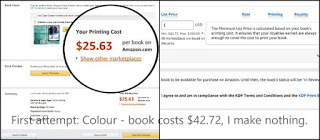
I now know that the printing cost is NOT the fixed charge. The printing cost is a separate issue, and I believe the fixed charge is one of the factors in the 60% royalty calculation. With a printing cost of $25.63, the cheapest a book can sell for (if you peer closely at the tiny writing in the right-hand box) is $42.72, and that’s only if I’m prepared to make no profit whatsoever. Quite how this is computed I have no idea, but figuring that B&W must be cheaper I went back to the drawing board—almost literally, since once again I was obliged to remake the covers with thinner spines (as the paper used in B&W printing is thinner). While I was at it I reformatted those few colour images into B&W in order to get the best results when they’re printed. Different colour images require different kinds of filtering to retain the greatest amount of detail when they’re converted into B&W. With that achieved, I tried again.
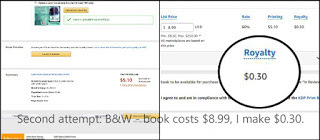
Oh, the sigh of relief when I saw the revised printing costs. This time the book in question—The Bridge of Dead Things—could sell for $8.50…if I was prepared to take nothing for all my efforts. I wasn’t. I priced it at $8.99, and you can see the actual royalty that will come to me with each sale. The majority of the books are somewhat shorter and are priced at $8.50 or less (with each earning me roughly the same profit margin), but I try to console myself with the fact that I have at least brought them in at under $10 a pop (a far cry from the $2.99 I was hoping to charge, however).
I now begin to understand why the template I downloaded was set at 11pt Garamond type and not 12pt. The smaller the font and the absence of any extra leading (rhymes with “wedding”), the fewer the number of pages there’ll be and the lower the printing cost. But 12pt is much easier on the eyes and, as a reader, I know how my heart sinks every time I open a book with small, cramped text. I don’t want that to be the reaction when someone opens one of my novels.
BTW, for those of you who helped me choose between sound tracks for the promo video, the overwhelming winner is…ta da! The Vivaldi. Thank you to everyone who responded and made the decision so much easier. It has now replaced the former videos on my website, on Amazon’s Author Central, at Smashwords, and, fingers crossed, here at Goodreads (I always need the librarians’ help with that).
I don’t know if you’ve noticed the festive season creeping up on us yet, but from the very first “brummm” nothing gets me in the spirit more than this. Wishing you all very happy holidays and a wonderful new year.
Do click! You’re in for a treat. Enjoy!
Happy reading!
Michael
Find me on my website, where you’ll discover regular special offers on all my novels
on Facebook
and @seventh7rainbow

I now know that the printing cost is NOT the fixed charge. The printing cost is a separate issue, and I believe the fixed charge is one of the factors in the 60% royalty calculation. With a printing cost of $25.63, the cheapest a book can sell for (if you peer closely at the tiny writing in the right-hand box) is $42.72, and that’s only if I’m prepared to make no profit whatsoever. Quite how this is computed I have no idea, but figuring that B&W must be cheaper I went back to the drawing board—almost literally, since once again I was obliged to remake the covers with thinner spines (as the paper used in B&W printing is thinner). While I was at it I reformatted those few colour images into B&W in order to get the best results when they’re printed. Different colour images require different kinds of filtering to retain the greatest amount of detail when they’re converted into B&W. With that achieved, I tried again.

Oh, the sigh of relief when I saw the revised printing costs. This time the book in question—The Bridge of Dead Things—could sell for $8.50…if I was prepared to take nothing for all my efforts. I wasn’t. I priced it at $8.99, and you can see the actual royalty that will come to me with each sale. The majority of the books are somewhat shorter and are priced at $8.50 or less (with each earning me roughly the same profit margin), but I try to console myself with the fact that I have at least brought them in at under $10 a pop (a far cry from the $2.99 I was hoping to charge, however).
I now begin to understand why the template I downloaded was set at 11pt Garamond type and not 12pt. The smaller the font and the absence of any extra leading (rhymes with “wedding”), the fewer the number of pages there’ll be and the lower the printing cost. But 12pt is much easier on the eyes and, as a reader, I know how my heart sinks every time I open a book with small, cramped text. I don’t want that to be the reaction when someone opens one of my novels.
BTW, for those of you who helped me choose between sound tracks for the promo video, the overwhelming winner is…ta da! The Vivaldi. Thank you to everyone who responded and made the decision so much easier. It has now replaced the former videos on my website, on Amazon’s Author Central, at Smashwords, and, fingers crossed, here at Goodreads (I always need the librarians’ help with that).
I don’t know if you’ve noticed the festive season creeping up on us yet, but from the very first “brummm” nothing gets me in the spirit more than this. Wishing you all very happy holidays and a wonderful new year.
Do click! You’re in for a treat. Enjoy!
Happy reading!
Michael
Find me on my website, where you’ll discover regular special offers on all my novels
on Facebook
and @seventh7rainbow
Published on December 01, 2017 05:47
•
Tags:
print-on-demand
November 1, 2017
November 2017: Just how easy is it to turn your novels into print?
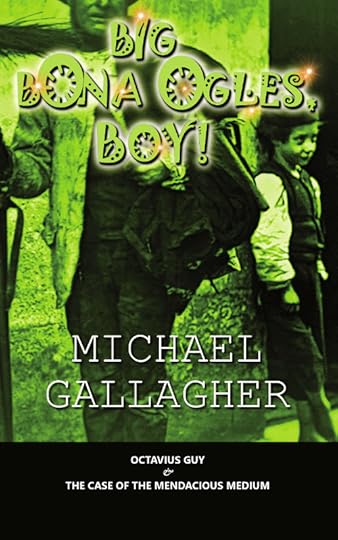 I can’t quite believe that I’ve just spent the past four months formatting my five novels for Amazon’s “print-on-demand”…and I still haven’t managed to finish yet. Why so long, you ask? Ah. Therein lies a tale. I downloaded the “easy” template, the 5”x8”, and started pasting in my text, only to discover a couple of kinks in the file that prevented me from doing this easily. No matter. I would format the text myself. Six weeks later I had almost finished all five novels (and made the covers with the downloadable cover templates, which really are a joy to use), when it occurred to me to print out a couple of test pages to see what they would look like. Oh dear. The typeface—11pt Garamond—looked very cramped and small. Nor was there any “leading” (rhymes with wedding), that tiny extra space between lines that allows your eye to travel quickly without losing your place. Back to square one.
I can’t quite believe that I’ve just spent the past four months formatting my five novels for Amazon’s “print-on-demand”…and I still haven’t managed to finish yet. Why so long, you ask? Ah. Therein lies a tale. I downloaded the “easy” template, the 5”x8”, and started pasting in my text, only to discover a couple of kinks in the file that prevented me from doing this easily. No matter. I would format the text myself. Six weeks later I had almost finished all five novels (and made the covers with the downloadable cover templates, which really are a joy to use), when it occurred to me to print out a couple of test pages to see what they would look like. Oh dear. The typeface—11pt Garamond—looked very cramped and small. Nor was there any “leading” (rhymes with wedding), that tiny extra space between lines that allows your eye to travel quickly without losing your place. Back to square one.You may be wondering why I couldn’t simply “select all” and change the type size to 12pt, then add some leading while I was at it. In fact I could and I did. But I also had to clear all the character spacing I’d put in—which had taken up most of my time—and begin the process over again. Five books. Over a third of a million words in total. Oh yes.
Character spacing, I hear you ask? Anyone who reads ebooks (or poorly formatted paperbacks) will know that you nearly always end up with those four or five words spaced badly across a line every time the first word in the next line is too long to be accommodated. But by decreasing the spacing between the letters, sometimes it can be made to fit. There’s a trade-off, however: gently does it, as the effect can be noticeable. Don’t whatever you do use “scale width”. The results are ghastly.
I also had to make a set of new covers because the books were now longer and fatter, and it’s at this point I learned about a little something called “colour profiles”. Oh, what a learning curve!Computers use an RGB profile (Red, Green, Blue), whereas commercial printing presses require a CMYK one (Cyan, Magenta, Yellow, blacK)—a profile which contains approximately only one third of the colours of RGB. That bright, bright green that practically fluoresces off the page in RGB ends up looking like the dark, dull peel of a lime in CMYK. Not one for surprises, I did the conversion myself (a process that takes a mere couple of clicks in Photoshop—the full version, not Elements; it’s the one thing Elements cannot do), and hey-ho: the dark, dull peel of a lime. At least I could now manipulate it into something a bit more acceptable. Photoshop also allows you to save the file as a “press quality” PDF, which is the kind Kindle asks for (though I suspect they automatically convert those that are not).
The one thing I’ve learned from all this is that every decision is a compromise. I can now see an end in sight (just) and hopefully at some point later this month all my titles will finally appear in print (sigh) without too many surprises or disappointments. To help publicize this, I’ve put together a video. Well, actually there are two videos, identical in every respect except for their soundtracks, and here I would love your help. Which one do I use? Vivaldi or Bach? I’d like to know what you think, especially if you’ve read any of the Octavius Guy books in the past. Only one will replace the previous ones on my website, here at Goodreads, on Amazon’s Author Central, and at Smashwords. But which? The Vivaldi? Or the Bach ?
Happy reading!
Michael
Find me on my website, where you’ll discover regular special offers on all my novels
on Facebook
and @seventh7rainbow
Published on November 01, 2017 06:36
•
Tags:
print-on-demand



